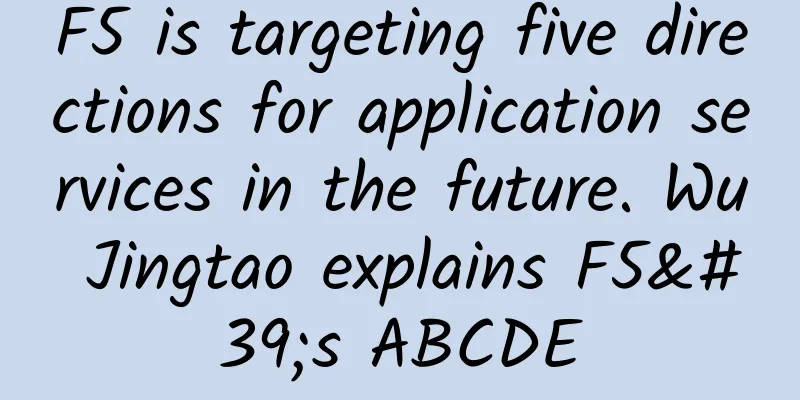F5 is targeting five directions for application services in the future. Wu Jingtao explains F5's ABCDE

|
[51CTO.com original article] At 9:00 am on May 22, the "2018 F5 China Application Service Summit Forum" was grandly held at the New Yunnan Crowne Plaza Hotel in Beijing. At the conference site with nearly 600 people, Wu Jingtao, Chief Technology Officer of F5 Greater China, delivered a keynote speech entitled "The Road to Application Services". In the 75-minute speech, Wu Jingtao first clearly sorted out the development of F5's main product line, and then shared F5's new ideas and development strategies for responding to changes in the application delivery field. He summarized it as F5's "ABCDE" - that is, through "AI Ops" and machine learning, using F5 as the network data engine of "BigData", to achieve "DevOps" visualization and improve "user Experience" in the "Cloud" environment. This speech was undoubtedly very successful, as many people stood in the audience to listen to his entire speech. What's more interesting is that every time Wu Jingtao changed a PPT on the screen, the sound of mobile phones taking pictures in the audience continued, and the whole venue was full of flash lights, just like a concert. The reporter interviewed Wu Jingtao after the meeting and asked him to explain in more detail F5's understanding of application services in a multi-cloud environment and the future direction of its efforts in the Chinese market.
Three issues reflect that application requirements have quietly changed At the beginning of the interview, the reporter threw the three questions he had raised at the conference back to Wu Jingtao and asked him to give answers. From his answers, the reporter could clearly feel that in the era of application economy, the connotation of application services is constantly changing. As the king of application delivery, F5 is also working hard to actively transform itself as application needs change, and provide better application services for large Chinese customers. The first question: What direction will application services go in? Wu Jingtao gave a very positive answer - "hardware + software + cloud services"; The second question is: when the user's application is deployed in the cloud, how to detect the application path and performance, and quickly find the cause of delay? Wu Jingtao said frankly that when the traditional data center transitions to cloud + DevOps, the past practice of adding network probes to spy on traffic like "candied haws strings" is no longer applicable. The development department directly controls the network, which brings great stability risks. In addition, the delivery strategies of the active-active center and different clouds are completely different, which brings new complexity and operation and maintenance risks. The three magic tools of "restarting applications, restarting servers, and reinstalling systems" have become invalid. "F5's approach is to deploy soft loads and virtual application services in the cloud." Wu Jingtao explained that F5 packages soft loads and virtual application services. The development department controls the packaged network services, while the network department still controls the delivery services in the form of hardware, and uses soft loads as a flexible extension in the cloud to form a unified delivery platform. For this reason, Wu Jingtao also emphasized the term "DevOps network middleware", which can realize probe-free visualization of east-west traffic within the data center, allowing APIs to directly call the required application services. The third question is, when F5 has achieved such a level of visualization control over traffic, what other space is there for F5 to "do more"? In Wu Jingtao's description, the reporter felt that this was like opening up the "Ren and Du meridians" of F5 products. F5 can use the traffic information it has to judge user experience, analyze user behavior, and manage application performance. It can even use financial language to talk about DC operations and KPI analysis. For example, the work report of data center operation and maintenance personnel is no longer boring "how many servers have been purchased, how much capacity has been expanded, and how many customers have been served", but becomes "how much the application service experience has been improved, how many users have been brought in, how many users have stayed on the product, and how much sales have been brought in" and other more convincing conclusions. "The most important thing is that this does not require customers to incur additional expenses. This is the traffic information controlled by the F5 device itself." Of course, Wu Jingtao also believes that this will be a very large market space, and it will be difficult for F5 to complete it alone. As stated at the venue, F5 hopes to actively communicate with partners to jointly develop this market in the future. At present, many domestic partners have very in-depth cooperation with F5, such as Huawei, N-Compass, Shenzhou Cloud Technology, etc. "We will provide customers with three models: one is to use open source, the second is to provide professional services by domestic commercial companies, and the third is through global technical cooperation." F5's path to application services: The direction has been determined and it is being pursued step by step When Wu Jingtao talked about F5's technology and planning, the question that popped up in the reporter's mind was "Why does F5 have such a keen sense of technology and can stay at the forefront of every change in the application market?" Wu Jingtao's interpretation of this is also very pertinent. He told reporters that it is not an easy task to maintain high performance of applications in a multi-cloud environment. The general difficulty and challenge in the industry lies in the processing of Layer 7, especially for mainstream switches at Layers 2 and 3, where port speed limit and high-speed and low-latency throughput are often two contradictory demands. And this is exactly where F5's technology is unique. Through the F5 TMOS architecture platform, F5 can achieve network stability and reliability, while also recognizing and understanding applications, and providing users with more flexible customized services. Just a few days ago, F5 released a new F5 Advanced WAF for multi-cloud application security. This product allows F5's customers to provide basic application security services for multiple cloud-private and public cloud-platforms, and to improve the convenience of services through microservices and containers. Based on the automated security policy function, the security solution can also provide cloud templates based on AWS, Google, and Azure environments to further shorten the deployment time of new applications. "Keeping pace with the times and grasping the most representative needs of customers seems to be F5's consistent style." He further explained that F5's development strategy in the application service field is not entirely F5's own judgment. In the past few months, he visited many large customers in China. During the communication, the customers gave more support and help, which made F5 clearer about its development direction. "Customers are actively trying to use emerging technologies for application services. F5 has an unshirkable responsibility to help customers accelerate transformation." At the end of the interview, Wu Jingtao concluded that F5 will focus on five aspects in the future. First, F5 will continue to sell high-performance hardware equipment for north-south traffic to ensure the reliability and stability of north-south traffic. Second, F5 will also focus on the internal traffic of the data center and provide multiple VE products for east-west traffic. Third, F5 can already achieve DevOps probeless and realize cloud application visualization through DevOps application middleware. Fourth, it provides customer experience customization and optimization services for mobile Internet. Fifth, AI OPS applications control the network and let applications manage the network. The reporter learned that F5 is currently the only company certified by China's "Five Clouds" and has maintained in-depth cooperation with Amazon AWS, Microsoft Azure, Alibaba Cloud, Tencent Cloud and Huawei Cloud. These five cloud providers occupy a large part of the domestic cloud market, so F5's multi-cloud application services will surely become more and more extensive, and the application service blueprint drawn by Wu Jingtao is slowly unfolding not far away. [51CTO original article, please indicate the original author and source as 51CTO.com when reprinting on partner sites] |
<<: Huawei and its global partners work together to build a full-scenario smart life
Recommend
Enterprise Network Data Communication Solution Practice - EIGRP
Practical objectives: Through practical applicati...
The 2G era will not come to an abrupt end; network transformation requires the support of the Internet of Things
Recently, China Unicom announced that it will car...
DesiVPS: Los Angeles 1Gbps unlimited traffic VPS for $22 per year, supports free IP change
DesiVPS has launched the Year End Stock Clearance...
Canceling traffic "roaming": Will there be 93 operators in China?
At the first session of the 13th National People&...
How many layers are in the TCP/IP protocol stack that you are learning? The standard answers in textbooks are changing
Overview Network knowledge is extensive and profo...
What exactly is 5G security and why is it important?
New technologies always bring with them a lot of ...
BalHost: $1.73/month-2GB/35G SSD/1Gbps unlimited traffic/Türkiye data center
Here is some information about Turkey VPS. The Ba...
Changting Technology's new product launch conference was held in Beijing to reconstruct a new network protection system
On July 14, Changting Technology, a provider of n...
5G and IoT: Compatible with each other
5G is here! It’s hard to ignore the hype surround...
edgeNAT Mid-Autumn Festival Promotion: 20% off for monthly VPS and 30% off for annual VPS, Hong Kong CN2/Korea CN2/US CUVIP optional
edgeNAT has sent out promotions for the Mid-Autum...
Android Network Programming-TCP/IP Protocol
In the article Android Network Programming - Comp...
5G and manufacturing advantages: optimism tempered
5G-enabled factories will have the ability to mai...
DiyVM: Japan Osaka/US Los Angeles/Hong Kong Shatin CN2 line 2G memory VPS monthly payment starts from 50 yuan
DiyVM has recently made major changes to the webs...
From "application availability" to "service accessibility" - the DNA innovation rule of Borei Data
[51CTO.com original article] In the past, users o...
The use of 6GHz spectrum is hotly debated. The mainstream view is that it is most suitable for 5G.
At the 7th Asia-Pacific Spectrum Management Confe...

![[Black Friday] RAKsmart top up $10 and get $10/top up $50 and get $30/top up $100 and get $50, VPS hosting starts from $0.99/month, cloud server starts from $2.49/month](/upload/images/67cac0112a62c.webp)







